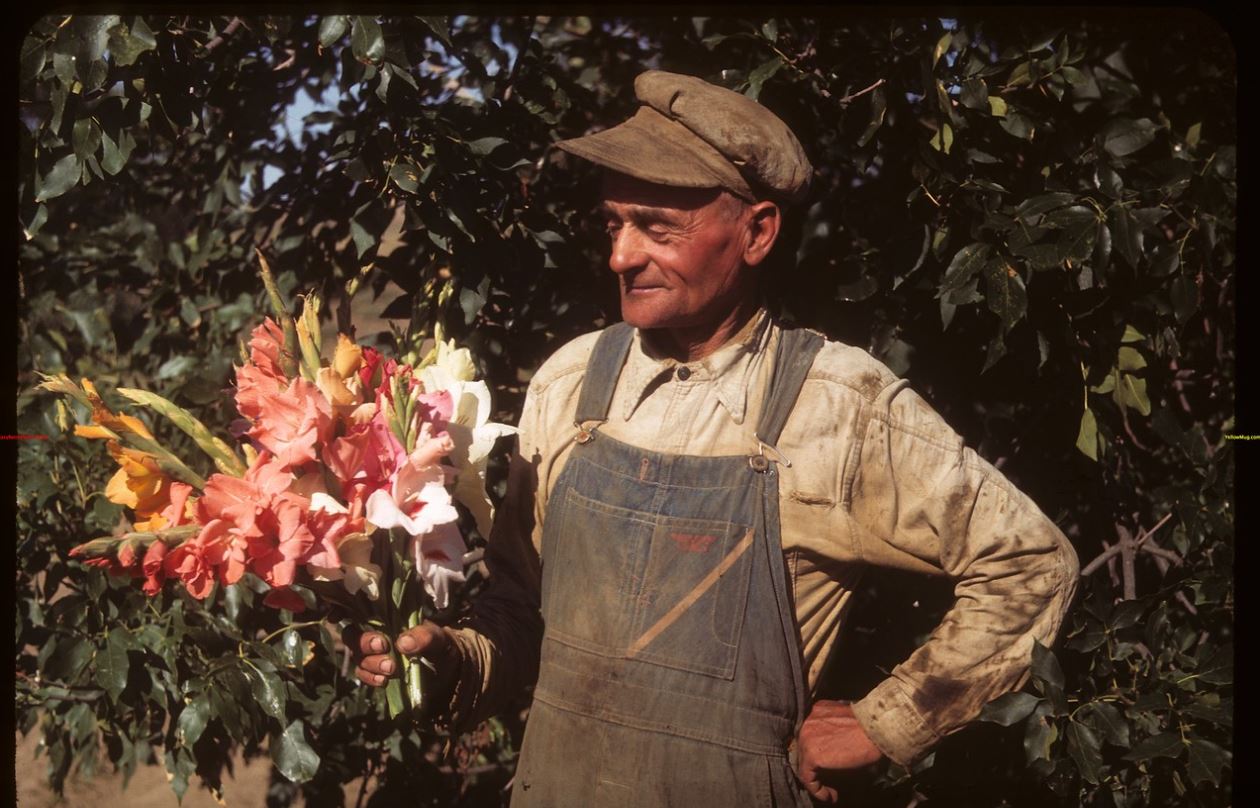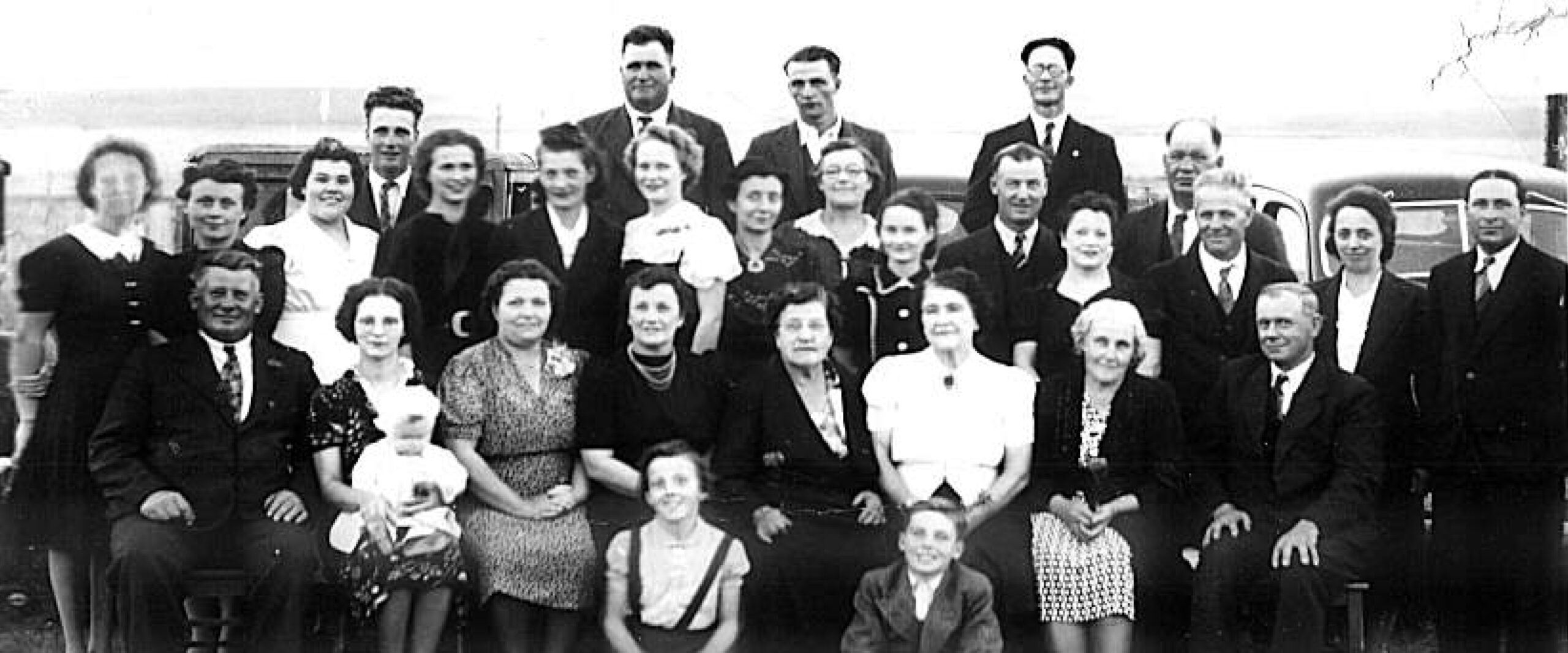





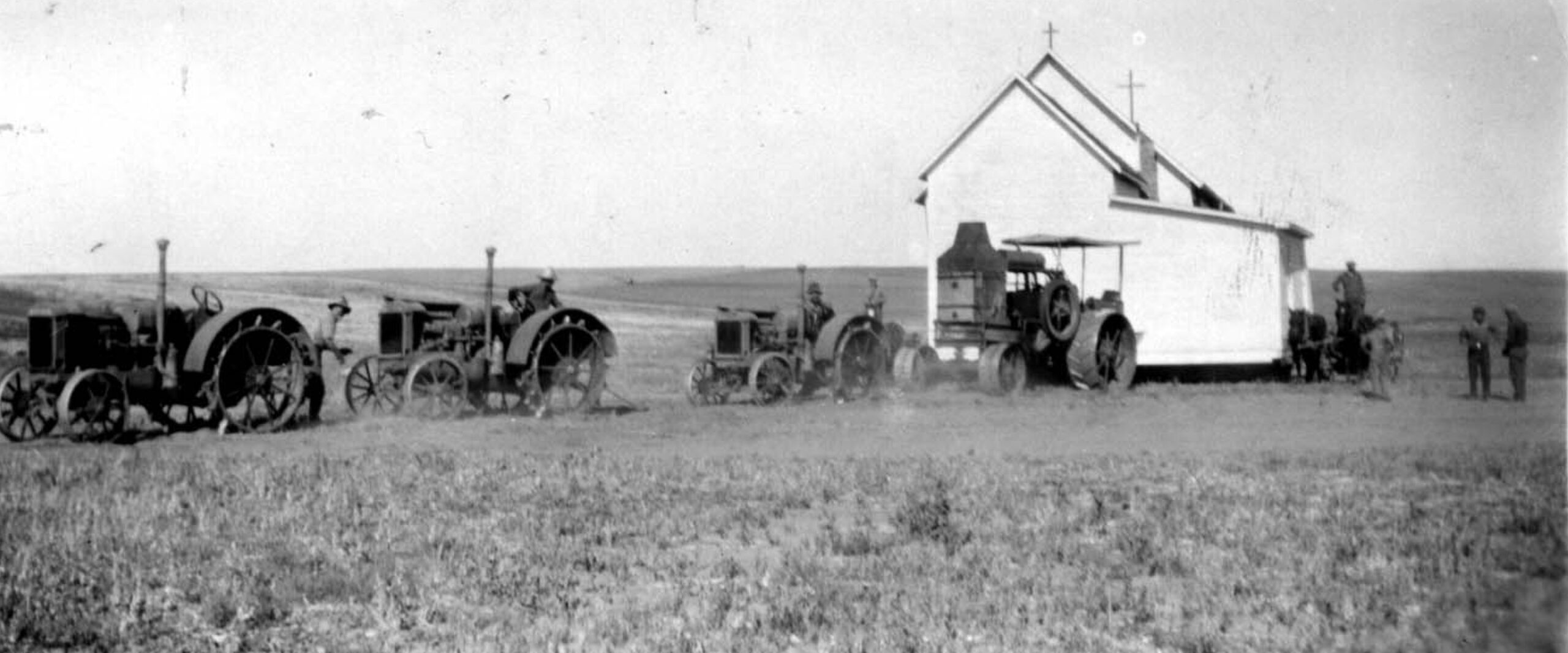


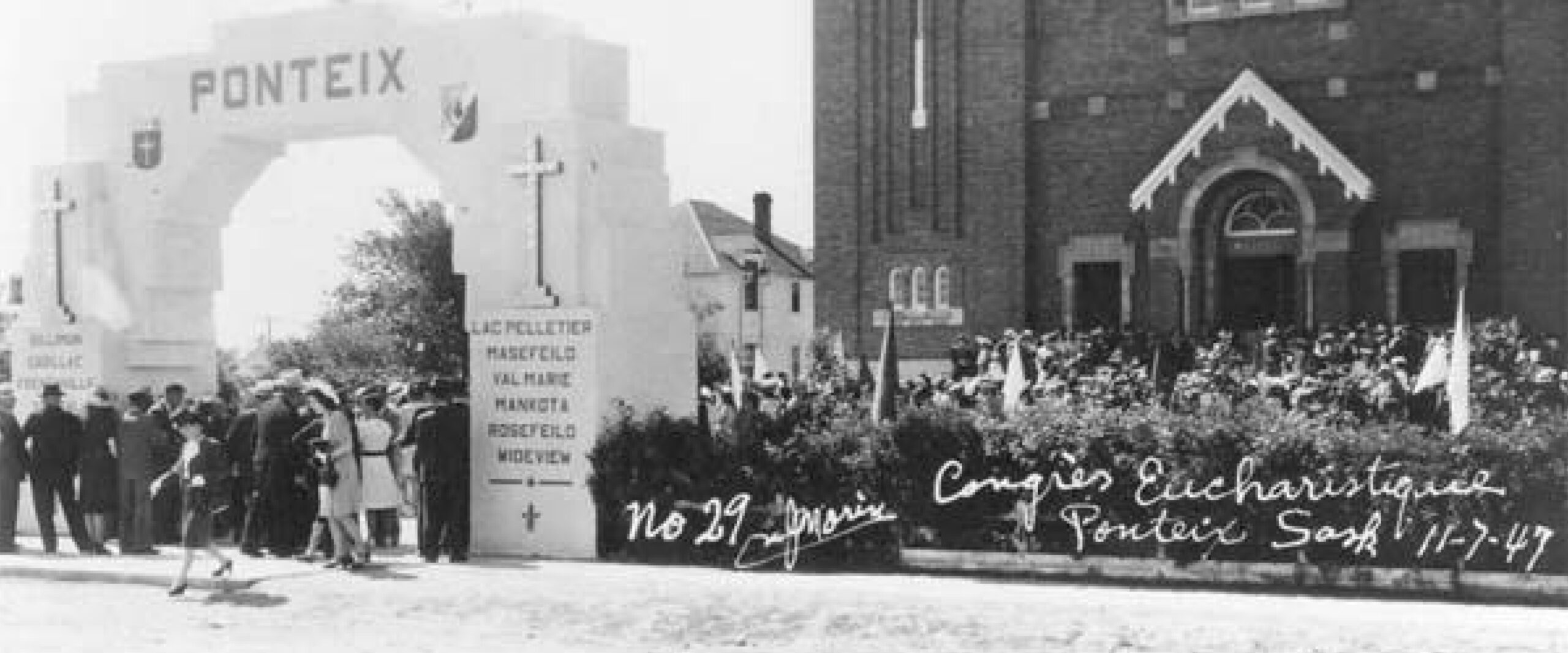






The parish of Notre-Dame-d’Auvergne was born out of Father Albert-Marie Royer’s dream of founding a parish which he would dedicate to the Virgin Mary. In 1907, after having studied the nature of the soil on several occasions, Father Royer made his choice on land which seemed promising to him, a land without wood but very fertile and easy to cultivate.
During the summer of 1913, the Canadian Pacific Railway extended its railroad network. The new track runs along the south bank of the Notukeu river. The distance by rail from Assiniboia, in the east, is seventy miles, and from Shaunavon, in the west, fifty. The importance attached to rail transport compels residents to move closer to the station. All the buildings of Notre-Dame – except the church – were then moved to the village which will henceforth bear the name of Ponteix, in homage to the parish formerly served by Abbé Royer in France.
“Since this exploration I often see my native village. I see myself on this coast near Luron, smiling as I see this modern little world … I see this little village that made me French Canadian. Thank you very much Ponteix, France. Thank you very much Ponteix, Saskatchewan. “

100 YEARS OF HISTORY
Historical Landmarks

Birth of the Parish of Notre-Dame-D’Auvergne
The parish of Notre-Dame-d’Auvergne was born of Father Albert-Marie Royer’s dream of founding a parish which he would dedicate to the Virgin Mary. He left France and travelled throughout Western Canada. In 1907, after having studied the nature of the soil on several occasions in this part of Southern Saskatchewan, Father Royer chose land which seemed promising to him, land without woods but very fertile and easy to cultivate. The arrival of the railway in 1913 caused the buildings of the budding Notre-Dame village and parish to be moved nearby. The village then adopted the name of Ponteix, in honour of Father Royer’s first French parish.

Arrival of the Sisters of Notre-Dame d'Auvergne
On January 15, 1913, Father Royer visited Mother Marie-du-Sauveur Alligier, then Superior General of the Sisters of Notre-Dame in Chamalières, Auvergne (France). On Thursday September 11, 1916, six sisters said their farewells to their companions and left their convent to take the train at Le Havre where they embarked on the Pomeranian and got off in Montreal on September 27 where they took the Canadian Pacific train to Regina before leaving for Swift Current. Three weeks after their departure from France, they finally arrived in Notre-Dame d’Auvergne, a village of 10 houses, a church, and a presbytery, where they were lodged in the presbytery which was still under construction. Their first reaction was “Dear God, give us faith!”. Among their precious objects brought from France, the precious statue of Notre-Dame du Port, placed over the door of the congregation’s chapel.
“The inconveniences of all kinds, inevitable in an unfinished house, without a furnace, when an icy breeze blew through the badly joined planks, all of this the sisters cheerfully put up with. Their convent was poor, but the stable in Bethlehem even more so! “
In January 2014, Mother Emmanuel and Sister Marie-de-la-Croix taught French at school during the morning and Miss Thériault, a young teacher, taught English at the boarding school. In 1915, the school inspector intervened, making the young teacher, who had the required diplomas, director of the school, and forbidding the sisters to teach in the school. In the spring of 1916, it was decided that a church and a convent would be built in Ponteix, the new village built around the station of the newly build railway.
Source: History of Ponteix, Sister Léa Robert

Construction of the first grain elevator
Grain elevators played an important role in the development of Ponteix. Over the years, millions of bushels of wheat and barley were loaded into railcars headed for seaports where they were shipped to Europe and various countries around the world.
There was a time when Ponteix had a total of six grain elevators running along the village railway line. The construction of the first elevator began in 1913 by the Pioneer company with a capacity of 22,000 bushels which was increased to 45,000 bushels in 1924. The final closure of this first elevator took place in 1973.
A second elevator was built in 1914 by State Elevator Co. It was sold to Western Grain and then again in 1951 to Pioneer Grain. The third elevator was built by Alberta Pacific in 1917. The fourth was built in 1917 by Saskatchewan Coop; in 1956, this company built a second elevator. The fifth elevator, also built in 1917 by Province, was sold to Reliance, then again to Searle Grain, Federal and finally to the Saskatchewan Wheat Pool. The sixth was built in 1924 by the Victoria company, then sold to McCabe and then to United Grain Growers.

Beginnings of the town of Ponteix
Ponteix was established as a village on June 24, 1914 and attained the status of “town” on April 1, 1957. During the summer of 1913, the Canadian Pacific Railway extended its railway network. The new track ran along the nearby south bank of the Notukeu river. The distance by rail from Assiniboia, in the east, is seventy miles, and from Shaunavon, in the west, fifty. The budding new town of Notre Dame had recently been created by l’Abbé Royer but the importance attached to rail transport compelled residents of the village to move their homes and businesses closer to the station. All the buildings of Notre-Dame – except the church – were moved to the new site which would henceforth bear the name of Ponteix, in homage to the parish formerly served by the Abbé Royer in France.

Our Financial Institutions
Ponteix’s financial institutions brought a lot of business to this dynamic town over the years. The Banque de Québec opened a branch in Ponteix as soon as the village moved to its new site in 1914, then merged with the Royal Bank in 1917. A branch of the Banque d’Hochelaga opened in 1915 with Alphonse Lévesque as manager then merged with the new National Bank of Canada in 1924; the BNC, located between Center Street and Kléber, remained in operation until June 1, 1950. The Northern Crown Bank opened a branch in Ponteix on December 10, 1915, merged with the Royal Bank of Canada in 1918 and still existed till _______ under the seal of the National Bank of Canada. The organization of the first Credit Union got under way in 1961 and opened a first location in 1962 at the top of the Liboiron Style Shop. There are presently two financial institutions in Ponteix, the RBC Royal Bank and the Innovation Credit Union.

Gabriel de Saint Joseph Hospital
From its inception, Ponteix was fortunate enough to have two resident doctors. The Gabriel Hospital opened in 1918. Rumour has it that the famous “Michelin” tire family in France funded the building of “L’Hopital Gabriel” which was named after one of their sons that was killed in an accident. The “Michelin” family home base is in the French city of Clermont Ferrand which is where the Sisters of Notre Dame have their mother house in France.
In October 1961, the Ponteix Chamber of Commerce held an assembly to organize a Union hospital district. A committee of volunteers led by Raymond Chabot, Ted Kouri and Marcel Carignan visited local farmers and “ranchers” to solicit their support and receive the taxes necessary to operate the future hospital. Ponteix’s Union Hospital was established in 1963 by order of Saskatchewan’s Lieutenant Governor and opened its doors to the public in 1967.

Threat of the Klu Klux Klan
In the 1920s, Klan meetings multiplied in Francophone communities across Saskatchewan. The French Canadians worked together to defend themselves against their attacks. Crosses were burned, citizens humiliated. Ponteix was one of the communities targeted by the Klan. Odette Carignan recounts the following episode:
“The Ku Klux Klans were very devious. They never attacked openly, their activities were carried out in the middle of the night, such as removing crucifixes from schools. In Ponteix, one of the school commissioners was Napoléon Carignan who absolutely did not want the crucifix to be removed from the school. So he slept in the school for two weeks; nothing happened. When he stopped sleeping at school, the crucifix disappeared. “
Another account relates how Ponteix francophones placed a spy within the Klan’s ranks. When Klan members opened the doors to the Ponteix church with the intent to burn it down, they were met by a parishioner holding a double barrel shotgun.
Sources: Saskatchewan Historical Society / University of Regina research project (Pratiques culturelles de la Saskatchewan Française)
Photo: Burning cross, Yorkton, Saskatchewan

Construction of the Poirier School
The first school classes were held in a temporary classroom in the nave of the Church of Notre-Dame. A one-room school was built in 1911. The first election of commissioners took place in 1910. The Notre-Dame school then moved to the new Ponteix School built on land provided free of charge by the Canadian Pacific Railway, where two classes were added. The school catered to students from grades 1 to 9. In 1922, the ten and eleventh grades were added. In 1923, the school was destroyed by fire. A temporary classroom was set up temporarily in the Lorenzino store, another in the basement of the United Church and a final classroom in the convent. In the fall of 1923, a brick school with seven classes was built. In 1924, the school adopted the name École Poirier in honor of Father Poirier who replaced Abbé Royer. In 1941, the school became the École de Ponteix.

Royal Canadian Mounted Police Detachment
The Ponteix RCMP detachment opened in 1928 when it absorbed the Saskatchewan Provincial Police. In 1939, the detachment moved to a house on Murat Street with a garage and five rooms, then moved again in 1966 to a new rental house. The Ponteix detachment is responsible for an area of approximately thirteen hundred square kilometers in addition to the Ponteix urban area.

Construction de l’église Notre-Dame d'Auvergne
Completed in 1929, the Our Lady of Auvergne Parish Church towers majestically over Ponteix. This impressive structure is the largest columnless church in Western Canada built of concrete and brick and is accented by impressive 40 metre twin spiers. The construction of this church cost an impressive $ 175,000 at the time. In May 1929, not long after the church’s completion, part of the building was destroyed by a cyclone. Without being discouraged, the parishioners raised the square, made the necessary repairs and the church reopened its doors in July of the same year. With the onset of the Economic Depression and the great drought, it took parishioners twenty-eight years to repay this large debt.
In 1930, the church was blessed by the first bishop of the new diocese of Gravelbourg (and future Cardinal of Quebec), Mgr Rodrigue Villeneuve, who nicknamed the impressive building “the Major Holy Mary of the diocese” and added that he planned to have this marvelous church erected as a basilica as soon as possible.

Construction of the Notre Dame Convent
Construction work on the convent of the Sisters of Notre-Dame d´Auvergne began on June 2, 1916. On June 18, the foundation stone of the convent was blessed. Due to the war, construction was delayed. It was only on November 16 that the move from the old Notre-Dame convent to the new Ponteix convent took place. Since the building was still under construction, school classes had to be reorganized. The convent had about sixty boarders and about twenty day-students. The sisters still had to deal with the problem of teaching English, as none of the sisters spoke that language, and the Saskatchewan government required instruction in English. To get around the problem, they called on a young lady from the village who agreed to give half-day lessons in English. In January 1917, Napoleon Lacoursière installed electricity in the convent, giving the sisters access to lighting and running water. Next challenge, where to find the funds to build a hospital?
Source: History of Ponteix, Sister Léa Robert

The annual Ponteix Pilgrimage
The 1930s were particularly difficult for the people of Saskatchewan. This is why, in 1934, during the drought years of the Great Depression, Monsignor A. Melanson, Bishop of Gravelbourg, asked his faithful to make a pilgrimage to ask the Virgin Mary for help. On July 16, 1936, several thousand pilgrims answered the call by traveling to Ponteix to visit his sanctuary. The shrine remained one of the two pilgrimage sites of the Diocese of Gravelbourg, and it is credited with at least one miracle.

Ponteix Eucharistic Congress
A large diocesan Eucharistic congress brought together the Catholics of the south-west of the province in Ponteix from July 11 to 13, 1947. If the honor of having launched the idea of such a congress goes to Mgr Marie-Joseph Lemieux, then administrator mission of the diocese of Gravelbourg, its success is due above all to the parishioners and to the parish priest of Ponteix, Mgr Louis Lussier.
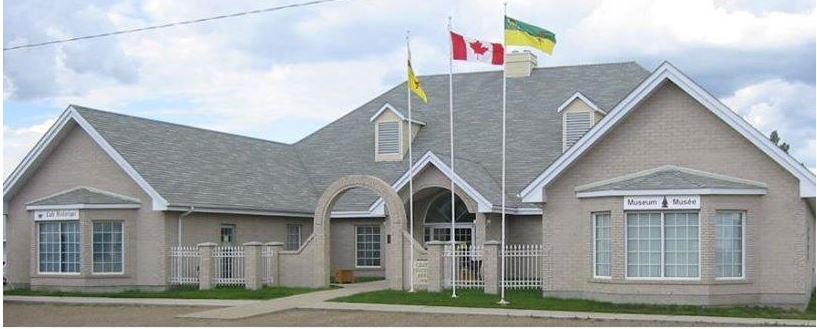
Construction of the Centre culturel communautaire Royer
The Centre culturel communautaire Royer, by its name, pays tribute to the Abbé Royer, French founder of the parish. This place of gathering, celebration, socialization, and education reaches both Francophones and Anglophones. At the heart of Ponteix’s Fransaskois community, the Royer Cultural Center makes it possible for residents to maintain and promote the town’s unique francophone culture and conserve its unique historical past by archiving a substantial collection of historical documents donated by the citizens of Ponteix. In this way, the Royer Cultural Center supports the local francophone community in its quest to promote bilingualism and furnish a French environment for groups wishing to organize social gatherings. The Center also houses the Notukeu Museum, a bowling alley, a games room, and a hall space dedicated to social and cultural events of all kinds.

Opening of the new École Boréale school
Ponteix’s École Boréale joined the other Fransaskois schools of the new Fransaskois provincial school board, the Conseil des écoles fransaskoises (CÉF), in 2015. The creation of the fransaskois school board was the direct result of the application of section 23 of the Charter of Rights and Freedoms, which gives Francophones in Saskatchewan the right to manage their educational institutions. The new school is built near the Royer Cultural Center. École Boréal offers education in French as a first language to students from preschool to grade 12. The building also houses a Fransaskois preschool, an early childhood education center and a resource center specially designed for the needs of students.
Details: http://boreale.ecolefrancophone.com/

Discovery of the Ponteix Plesiosaur fossils
“MO” is the only known specimen of this long-necked plesiosaur which was found 6 km northeast of Ponteix by local farmers Bob St. Cyr and Henri Liboiron. Terminonatator ponteixensis lived near the end of the Cretaceous Period (70 million years ago), when the last remnants of the Western Interior Seaway were still covering much of Saskatchewan.
The deposits that contain “Mo” belong to a rock unit called the Bearpaw Formation, which is found throughout much of southern Saskatchewan. The proportionally small head, with long, thin teeth suggests that “Mo” was a fish eater. If “Mo” had attempted to eat prey with larger or thicker bones, it would have broken its teeth. It is believed that the long neck could have aided in the capture of schooling fish. One of the odd things about this plesiosaur was that it ate stones (found in the stomach, these stones are called gastroliths). Gastroliths may have been used to counter buoyancy or possibly to help in food processing
Source: Royal Saskatchewan Museum

Ponteix celebrates its 100th anniversary!
The celebrations for the 100th anniversary of the town of Ponteix took place August 1- 3, 2019. On this special occasion, the history of this small French-speaking community was put in the spotlight. The Royer Cultural Center presented a historical exhibition for the occasion, while the school and church organized guided tours. Several former residents returned to the village to reunite with family and friends and celebrate together. As part of the presentation of the Fransaskois flag, Saskatchewan’s legislative secretary responsible for Francophone affairs, Mr. Wayne Elhard, underlined the fact that the work of the first settlers and the sustained efforts of the current residents “reinforce not only the Fransaskois community, but all of Saskatchewan. “

Hydroponics, an ambitious project!
In 2021, the Auvergnois de Ponteix set in motion an ambitious hydroponic production project that involves students and teachers from the École Boréale school. Children are presently able to grow their own salads and vegetables. Moreover, the project has been carried out in collaboration with the Conseil des écoles fransaskoises (CEF), Saskatchewan’s francophone school board. The facility holds approximately 120 plants. The village of Ponteix generously provided land near the school to place the hydroponic greenhouse. The Auvergnois of Ponteix are planning to sell the fresh produce grown in the greenhouse to residents of Ponteix and the outlying region.
Video gallery
Our history, our heritage






